BIO299 Research Practice in Biology is a 10 ECTS course for students at the department of Biological Sciences (UiB).
Students must find a supervisor and research project as part of the course deliverables. On these pages, we have listed potential projects for BIO299 in our group Between the Fjords.
Suggested BIO299 project topics
10 years of data collection: a reproducibility case study
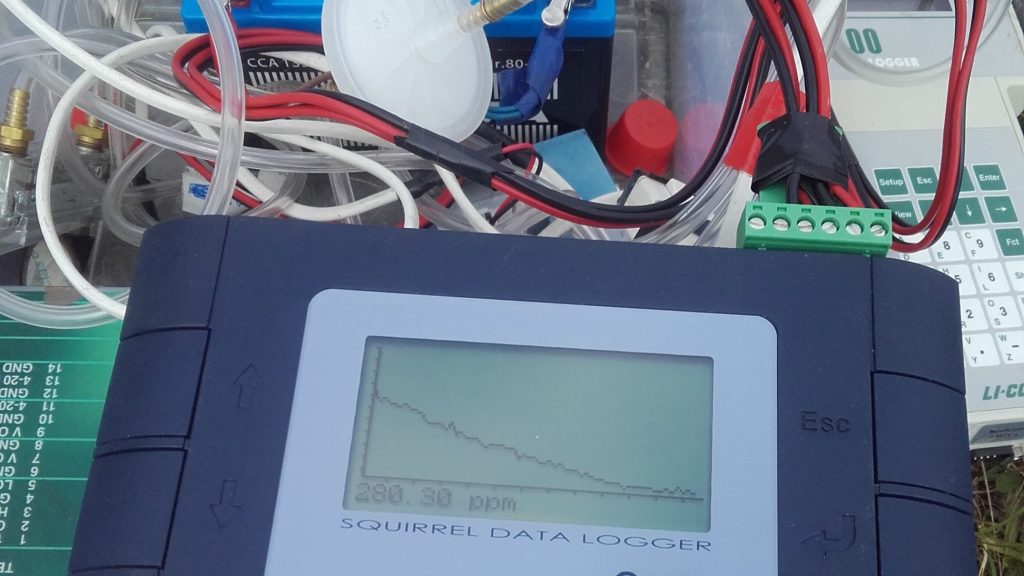
Since 2015, the Plant Functional Traits Courses have collected ecosystem gas fluxes data in China, Peru, Svalbard, western Norway and South Africa. But since 2015, the method to process such data has also evolved a lot, and we have now developed the fluxible R package to make it reproducible and faster. There is now an exciting “data forensics” opportunity: gathering the original raw data, reprocessing them with the fluxible R package, and compare them to the originally published data. This is an opportunity to learn about state of the art reproducibility in ecology and data management, improve coding skills to handle large datasets, and get an insight in the bubble of R package development. The reprocessed data are planned to be used in a global flux study in which the student would be invited. Further collaboration in the development of the fluxible R package is also a possible follow-up of that project. Interested? Reach out to Joseph Gaudard Requirements for prior knowledge and other practicalities Basics in R coding and use of GitHub, but a lot of help will be available. Flexible timing and remote work are possible. The project is hosted at the Between the Fjords lab: https://betweenthefjords.w.uib.no/home/In collaboration with the Plant Functional Traits Courses: https://plantfunctionaltraitscourses.w.uib.no/courses/And with the fluxible R package development team: https://plant-functional-trait-course.github.io/fluxible/
What do people really know about nature, and the biodiversity crisis?

To solve the biodiversity crisis, we need to stop the spread of alien species, stop sacrificing nature to build stuff, and protect areas and species that need protection. But to do so, people need to understand, know, and value nature and biodiversity. In this project we will try to figure out what people know about nature and the biodiversity crisis by conducting surveys. This can be testing people’s species knowledge, learning more about a concept called “plant blindness” in a Norwegian setting, or identify misconceptions people have about nature and the biodiversity crisis. You will take part in shaping in which direction this project goes by choosing which topic and method you want to investigate and use (species knowledge, plant blindness, connection to nature, or identify misconceptions), and which group of people you want to investigate (general public, students at UiB, students in school). Your data will be a pilot and build knowledge for a bigger proposal – so you really get to be a part of a scientific process here. Skills you develop: reading scientific literature, survey methods, critically evaluating different methods against each other, socio-ecological research. Interested? Reach out to Ragnhild Gya
In-depth study of microclimate manipulations in a global warming ecology experiment
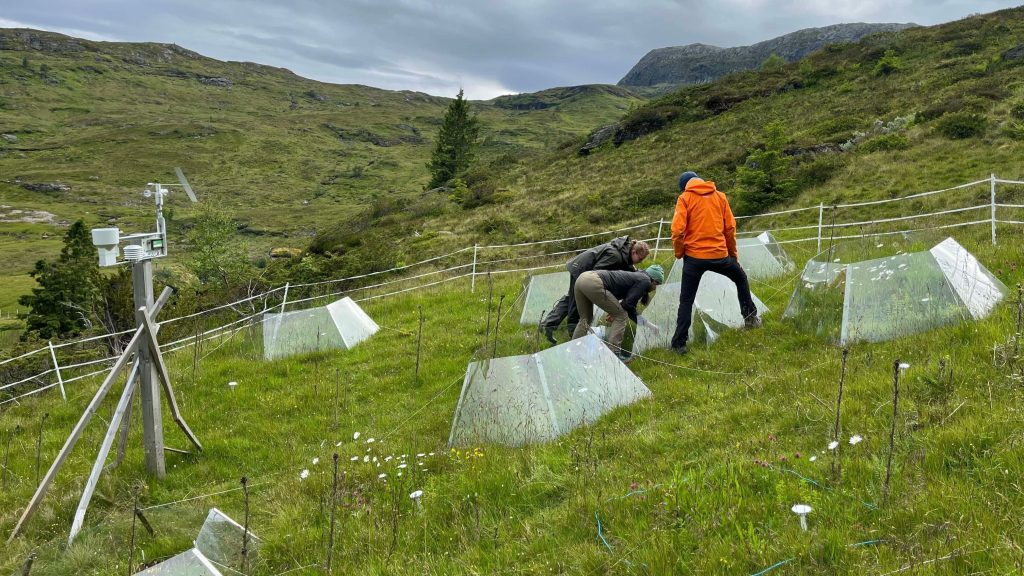
In this project you get to work with climate data from microclimate loggers, and local climate stations. We use these data to fully disentangle the effect of mini-greenhouses, called Open-Top Chambers (OTCs) that are being used in climate change experiments in alpine and arctic ecosystems worldwide to investigate the effect of climate warming on vegetation. These open-top chambers are designed to heat the vegetation with approximately 2 degrees, without much side effects. We have an experiment with these chambers at four different locations from 2018 till present day. With these data we have the opportunity to look into the effects of these chambers on a windy day, the effects on soil moisture, heating differences at different times of day, etc. All of these could have consequences for our experiment, and other experiments using the same method globally. Being able to work with big data is a more and more acquired trait from the work force, and would be a great advantage for the work with a masters thesis. Skills you will develop: working with big data, data management, critically analyze climate change experiment data, familiarize yourself with a commonly used method in climate change experiments Interested? Reach out to Ragnhild Gya & Joseph Gaudard Requirements for prior knowledge It is an advantage if you have some prior knowledge of data management and/or experience with coding in R/python or other languages. Motivation to learn can also get you very far.
Germination patterns of heathland dwarf shrubs (Durin)
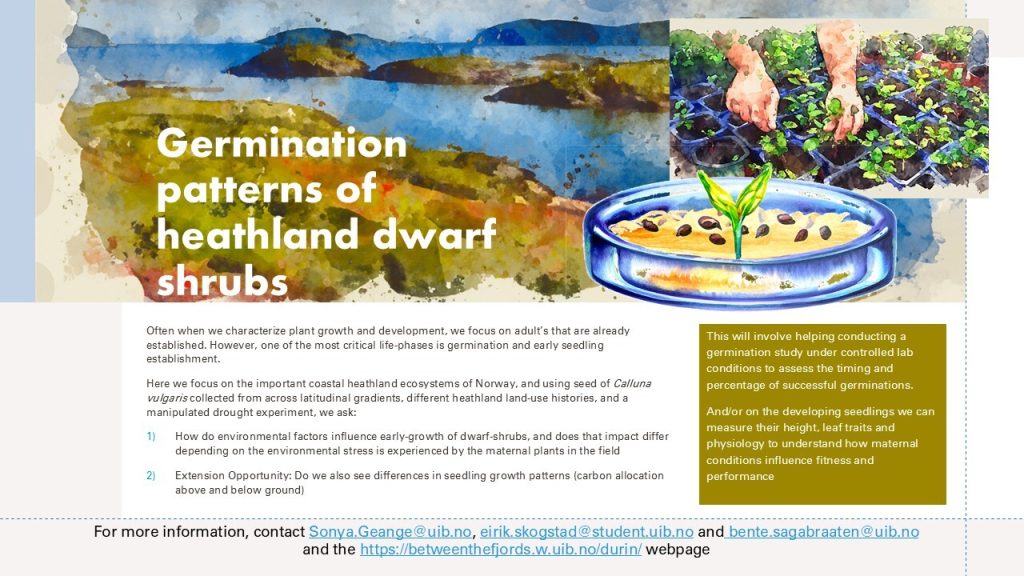
Often when we characterize plant growth and development, we focus on adult’s that are already established. However, one of the most critical life-phases is germination and early seedling establishment. Here we focus on the important coastal heathland ecosystems of Norway, and using seed of Calluna vulgaris collected from across latitudinal gradients, different heathland land-use histories, and a manipulated drought experiment, we ask: How do environmental factors influence early-growth of dwarf-shrubs, and does that impact differ depending on the environmental stress is experienced by the maternal plants in the field Extension Opportunity: Do we also see differences in seedling growth patterns (carbon allocation above and below ground) For more information, contact Sonya.Geange@uib.no, eirik.skogstad@student.uib.no and bente.sagabraaten@uib.no . Also visit the DURIN webpage! Practicalities This will involve helping conducting a germination study under controlled lab conditions to assess the timing and percentage of successful germinations. And/or on the developing seedlings we can measure their height, leaf traits and physiology to understand how maternal conditions influence fitness and performance
The environmental requirements of dwarf-shrubs (Durin)
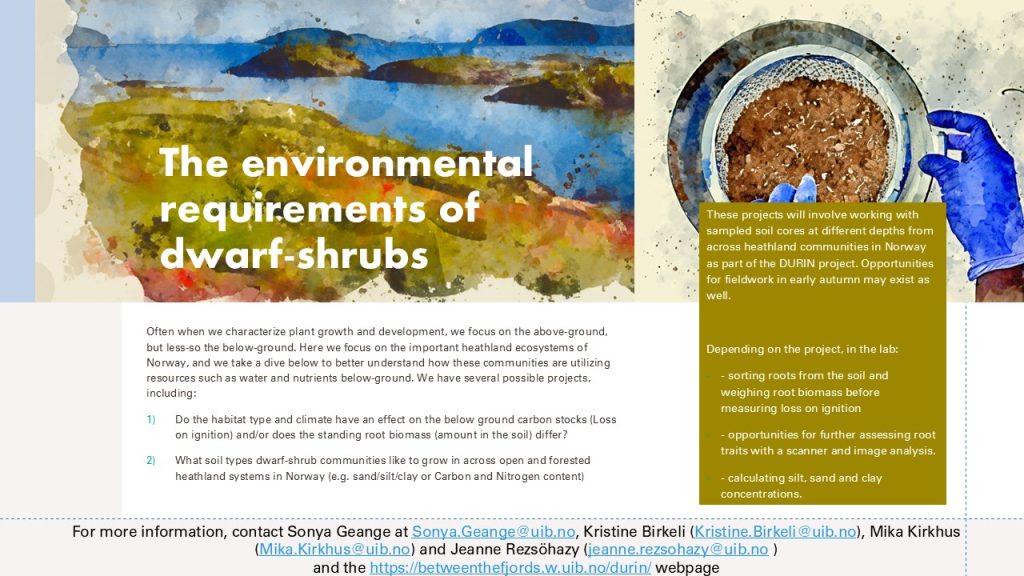
Often when we characterize plant growth and development, we focus on the above-ground, but less-so on the below-ground. Here we focus on the important heathland ecosystems of Norway, and we take a dive below to better understand how these communities are utilizing resources such as water and nutrients below-ground. We have several possible projects, including: Do the habitat type and climate have an effect on the below ground carbon stocks (Loss on ignition) and/or does the standing root biomass (amount in the soil) differ? What soil types dwarf-shrub communities like to grow in across open and forested heathland systems in Norway (e.g. sand/silt/clay or Carbon and Nitrogen content)? For more information, contact Sonya Geange at Sonya.Geange@uib.no, Kristine Birkeli at Kristine.Berkeli@uib.no, Mika Kirkhus at Mika.Kirkhus@uib.no and Jeanne Rezsöhazy at jeanne.rezsohazy@uib.no Also visit the DURIN webpage! These projects will involve working with sampled soil cores at different depths from across heathland communities in Norway as part of the DURIN project. Opportunities for fieldwork in early autumn may exist as well. Depending on the project, the lab work could include: Sorting roots from the soil and weighing root biomass before measuring loss on ignition Opportunities for further assessing root traits with a scanner and image analysis. Calculating silt, sand and clay concentrations.
Soil carbon stocks
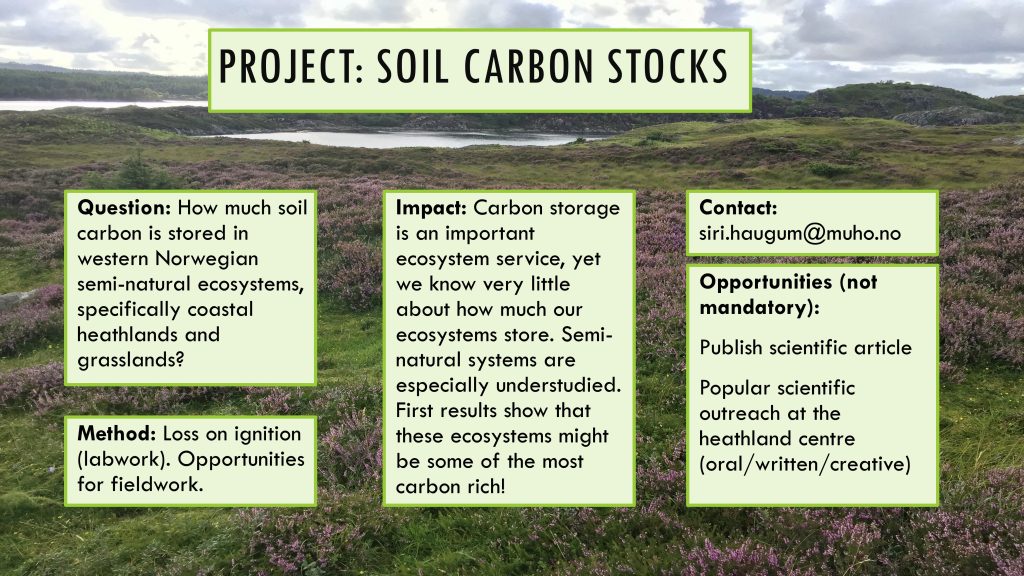
Carbon storage is an important ecosystem service, yet we know very little about how much our ecosystems store. Semi-natural systems are especially understudied. First results show that these ecosystems might be some of the most carbon rich! Question: How much soil carbon is stored in western Norwegian semi-natural ecosystems, specifically coastal heathlands and grasslands? For more information, reach out to Siri Haugum at the Heathland centre / Lyngheisenteret
How can we characterize the microclimates of dwarf-shrubs? (Durin)
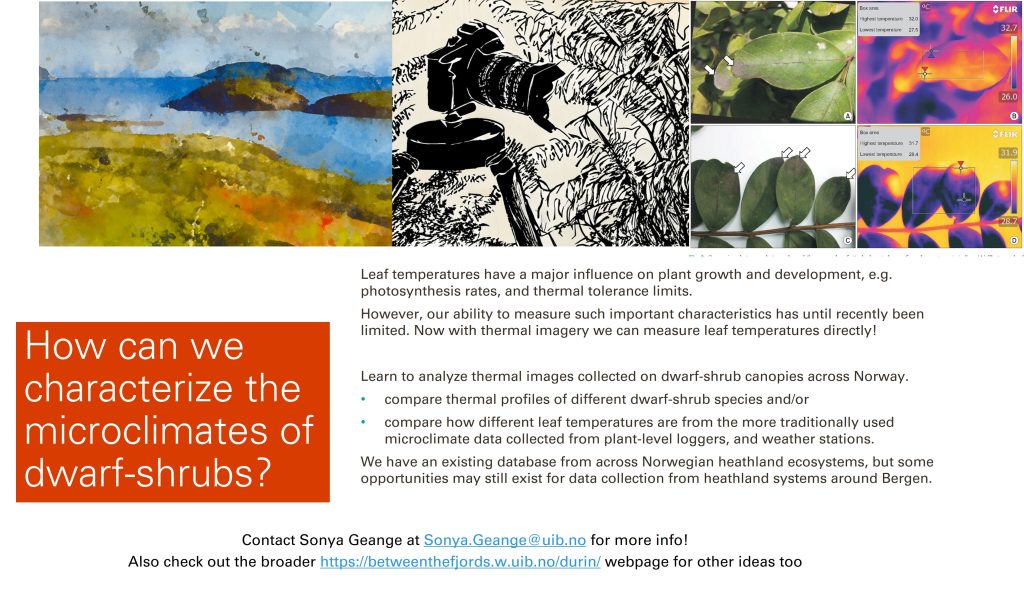
Leaf temperatures have a major influence on plant growth and development, e.g. photosynthesis rates, and thermal tolerance limits. However, our ability to measure such important characteristics has until recently been limited. Now with thermal imagery we can measure leaf temperatures directly! Learn to analyze thermal images collected on dwarf-shrub canopies across Norway. compare thermal profiles of different dwarf-shrub species and/or compare how different leaf temperatures are from the more traditionally used microclimate data collected from plant-level loggers, and weather stations. We have an existing database from across Norwegian heathland ecosystems, but some opportunities may still exist for data collection from heathland systems around Bergen. Have a look at the DURIN page and contact Sonya Geange at Sonya.Geange@uib.no for more info!
How dwarf-shrubs allocate carbon (Durin)
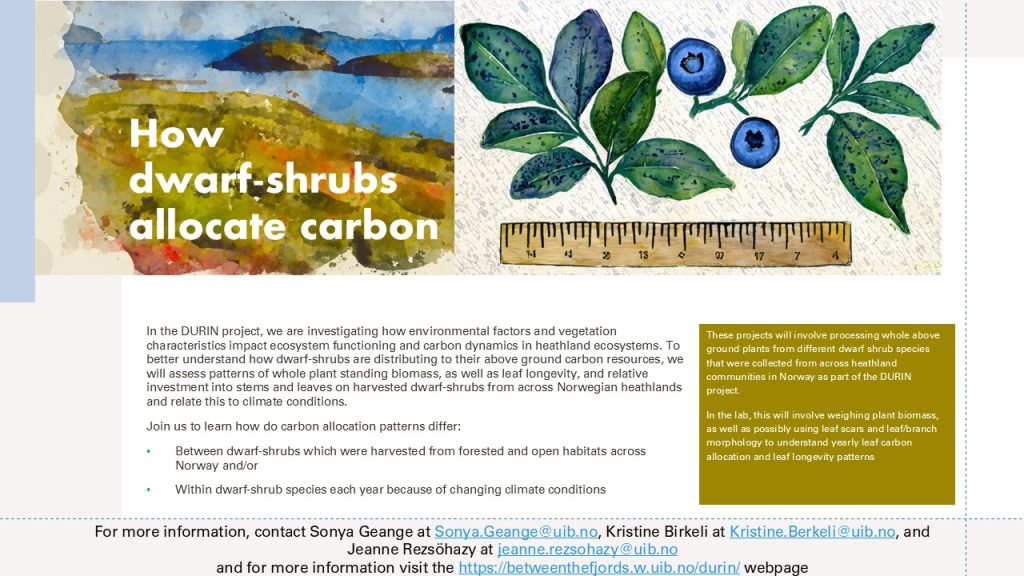
In the DURIN project, we are investigating how environmental factors and vegetation characteristics impact ecosystem functioning and carbon dynamics in heathland ecosystems. To better understand how dwarf-shrubs are distributing to their above ground carbon resources, we will assess patterns of whole plant standing biomass, as well as leaf longevity, and relative investment into stems and leaves on harvested dwarf-shrubs from across Norwegian heathlands and relate this to climate conditions. Join us to learn how do carbon allocation patterns differ: Between dwarf-shrubs which were harvested from forested and open habitats across Norway and/or Within dwarf-shrub species each year because of changing climate conditions For more information, contact Sonya Geange at Sonya.Geange@uib.no, Kristine Birkeli at Kristine.Berkeli@uib.no, and Jeanne Rezsöhazy at jeanne.rezsohazy@uib.no Also visit the DURIN webpage!
